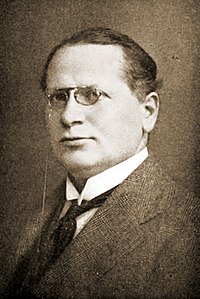Litvinov Protocol

The Litvinov Protocol is the common name of an international
The formal name of the Litvinov Protocol as registered with the League of Nations was the "Protocol for the Immediate Entry into Force of the Treaty of Paris of August 27, 1928, Regarding Renunciation of War as an Instrument of National Policy." The treaty is also sometimes known as the "Moscow Protocol."
Initial signatories of the Litvinov Protocol included the
Background

Near the end of 1927 correspondence between the foreign diplomatic corps of
The
Soviet People's Commissar of Foreign Affairs Georgy Chicherin was also sharply critical of the decision to keep the USSR from taking an active part in treaty negotiations as well as formal reservations to the treaty expressed by the governments of Great Britain and France.[4]
While it deeply suspected the political intentions behind the Kellogg–Briand Pact, at the same time the Soviet government sought to both score political points in the court of public opinion and to establish at least some modicum of diplomatic security by endorsing the proposed treaty's ban on the use of war as an instrument of policy.[3] By the summer of 1928 it had become clear to foreign policy observers that the Soviet Union was actively seeking a place at the negotiating table that led to creation and signature of the Paris Treaty, with Chicherin, an opponent of making the USSR a party to the multilateral treaty, having lost the policy debate to Deputy People's Commissar of Foreign Affairs and veteran Soviet diplomat Maxim Litvinov, a treaty supporter.[5]
Although the USSR was excluded from the honor of being a founding signatory of the Kellogg–Briand Pact on August 27, on the same day of the treaty's signing an official invitation to accede to the pact was presented to the governments of all other countries of the world and the Soviet government was quick to add its name to the list of signatories.[2] On August 29 the governing Presidium of the Central Executive Committee of Soviets (TsIK), the nominal head of government, passed a formal resolution to accept the treaty — a result which Litvinov related to peace commission functionaries the following day.[2] An act of formal accession to the Paris treaty was ratified on September 8, 1928.[2]
In an official Izvestiya editorial dated September 7, 1928, the Soviet government deemed its acceptance of the Paris pact had been made "in order to point out the insufficiency of the proposed obligations, and to demand the broadening of these obligations so as truly to safeguard peace" — something which could be achieved only through "positive and fruitful work on disarmament."[6] Such desires were rapidly frustrated as the ratification process by diverse signatories bogged down. Four months after the treaty was signed, not one of the signatories had formally ratified it.
Conception
Once it had decided to add itself to the signatories of the Paris antiwar accord, the government of the Soviet Union, whether for propaganda or practical purposes, became the Kellogg–Briand Pact's leading supporter, attempting to bring it into force with neighboring countries.[7] On December 29, 1928, Litvinov proposed an additional protocol to the Paris treaty bringing it into immediate effect in the USSR's bilateral relations with historic enemy Poland and newly independent former part of the Russian Empire Lithuania.[7]
Poland was first to respond to this Soviet initiative, putting forward a counterproposal to include its military ally,
The document accelerating acceptance of the Kellogg–Briand principles became commonly known as the "Litvinov Protocol" or the "Moscow Protocol."[7] The formal name of the document, as registered with the League of Nations, was the "Protocol for the Immediate Entry into Force of the Treaty of Paris of August 27, 1928, Regarding Renunciation of War as an Instrument of National Policy."[8]
Signing
The treaty was ratified by the government of Latvia on March 5, 1929, by Estonia on March 16, 1929, and the governments of Poland and Romania on March 30, 1929. It was registered in League of Nations Treaty Series on June 3, 1929.[9] According to article 3, it became operative on March 16, 1929.
Effect and legacy
The Litvinov pact was an enrichment of the Kellogg-Briand pact to ensure that the USSR had sufficient time to recuperate and rebuild the Soviet state in the 1920s. During the 1930s, the pact began to deteriorate, as disputes by member states increased in frequency and severity. The Polish–Czechoslovak border conflicts severely damaged the pact in 1938, with the aid of Nazi Germany, Poland annexed portions of Czechoslovakia. Finally, the USSR fatally undermined the pact when it invaded Poland in 1939.
References
- ^ E.H. Carr, A History of Soviet Russia 12: Foundations of a Planned Economy, 1926-1929: Volume 3, Part 1. London: Macmillan, 1976; pg. 109. Hereafter: Foundations of a Planned Economy.
- ^ a b c d e Carr, Foundations of a Planned Economy, vol. 3, pg. 113.
- ^ a b c Carr, Foundations of a Planned Economy, vol. 3, pg. 110.
- ^ Xenia Joukoff Eudin and Robert M. Slusser, Soviet Foreign Policy, 1928–1934: Documents and Materials: Volume 1. University Park, PA: Pennsylvania State University Press, 1966; pg. 6.
- ^ Carr, Foundations of a Planned Economy, vol. 3, pg. 111.
- ^ Izvestiia, Sept. 7, 1928, cited in Eudin and Slusser, Soviet Foreign Policy, 1928–1934, vol. 1, pg. 6.
- ^ a b c d e Eudin and Slusser, Soviet Foreign Policy, 1928–1934, vol. 1, pg. 7.
- ^ League of Nations Treaty Series, "Protocol for the immediate entry into force of the Treaty of Paris of August 27, 1928, regarding renunciation of War as an Instrument of National Policy. Signed at Moscow, February 9, 1929," LNTSer 123; 89 LNTS 369.
- ^ League of Nations Treaty Series, vol. 89, pp. 370–379.
